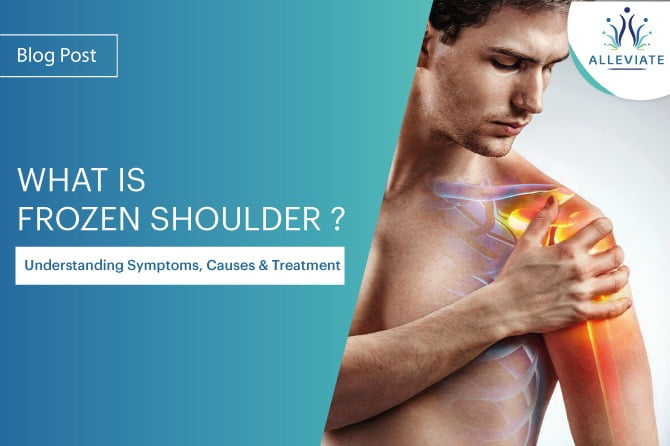Introduction
Frozen shoulder, also known as adhesive capsulitis, is a debilitating condition characterized by pain, stiffness, and restricted mobility in the shoulder joint .Commonly seen in diabetics, frozen shoulder is a musculoskeletal disorder that affects the shoulder joint, leading to progressive pain, stiffness, and decreased range of motion. It is a challenging condition that can significantly impact a person’s daily life and functionality. This article aims to provide a comprehensive understanding of frozen shoulder by examining its definition, symptoms, underlying causes, diagnostic methods, and the various treatment options available.


What is Frozen Shoulder?
Frozen shoulder, medically known as adhesive capsulitis, is a condition characterized by the gradual and often painful loss of motion in the shoulder joint. It typically progresses through stages, each marked by varying degrees of pain and stiffness. The hallmark feature of frozen shoulder is the thickening and tightening of the joint capsule—the connective tissue that surrounds the shoulder joint. This tightening restricts the joint’s ability to move freely.


Symptoms of Frozen Shoulder
- Pain : Individuals with frozen shoulder often experience aching pain in the shoulder, which may worsen during movement or at night.
- Stiffness : Progressive stiffness is a prominent symptom. Initially, the shoulder may have limited range of motion, but over time, it can become severely restricted.
- Limited Range of Motion : As the condition advances, patients find it increasingly difficult to perform daily activities that involve raising the arm, such as reaching overhead or behind the back.
- Difficulty Sleeping : Pain and discomfort in the shoulder can disrupt sleep patterns, leading to sleep disturbances and fatigue.
- Progressive Nature : Frozen shoulder tends to progress through stages, including the freezing stage, frozen stage, and the thawing stage, each with distinct symptoms.
Causes of Frozen Shoulder
The exact cause of frozen shoulder is not always clear, but several risk factors and contributing factors have been identified:
- Age and Gender : It predominantly affects individuals between the ages of 40 and 60, and it is more common in women.
- Prior Injury or Surgery : A history of shoulder injury or surgery can increase the risk of developing frozen shoulder.
- Systemic Diseases : Certain medical conditions, such as diabetes, cardiovascular disease, and autoimmune disorders, have been associated with a higher risk of frozen shoulder.
- Immobilization : Prolonged periods of shoulder immobility due to injury or illness can trigger the development of adhesive capsulitis.
- Genetic Predisposition : Some genetic factors may make certain individuals more susceptible to developing frozen shoulder.
Diagnosis of Frozen Shoulder
Diagnosing frozen shoulder typically involves:
- Medical History : The healthcare provider will review the patient’s medical history and inquire about their symptoms and any previous shoulder injuries or surgeries and very importantly check for History of Diabetes.
- Physical Examination : A thorough physical examination, including an assessment of the shoulder’s range of motion and palpation of the joint, is conducted.Painfully limited range of movement is often observed in the early stages and it progresses to more limitation and less pain as the disease progresses.
- Imaging : X-rays, MRI scans, or ultrasound may be ordered to rule out other shoulder conditions and assess the extent of the joint’s tightness and inflammation.
Treatment for Frozen Shoulder
The treatment approach for frozen shoulder is often tailored to the stage of the condition and the severity of symptoms. Common treatment options include:
- Physical Therapy : Physical therapy exercises aim to improve range of motion , trying to gradually break the adhesions and reduce pain.
- Medications : Non-steroidal anti-inflammatory drugs (NSAIDs) and corticosteroid injections can provide pain relief and reduce inflammation.
- Heat and Ice : Applying heat or ice to the affected area can help alleviate pain and promote relaxation of the shoulder muscles.
- Home Exercises : Patients are often prescribed home exercises to perform daily to gradually improve shoulder mobility.
- Hydrodilatation : This procedure involves injecting sterile water into the joint capsule to stretch it and improve range of motion.
- Manipulation Under Anesthesia (MUA) : In some cases, MUA may be recommended to break up adhesions in the joint capsule under anesthesia.
- Surgery : Surgical intervention is rarely necessary but may be considered in severe, refractory cases. Procedures may include capsular release or arthroscopic surgery.
AT ALLEVIATE, we have seen more than 90% success rate with frozen shoulder patients treated with our combined approach involving hydrodilatation, suprascapular nerve block and manipulation followed by 2-3 weeks of physical therapy.


HYDRODILTATION UNDER FLUOROSCOPIC GUIDANCE


Suprascapular Nerve Block using Fluoroscopy
Conclusion
Frozen shoulder, or adhesive capsulitis, is a painful and debilitating condition characterized by shoulder pain, stiffness, and restricted mobility. While its exact cause remains elusive, various risk factors and contributing factors have been identified. Early diagnosis and appropriate treatment are crucial to managing the condition effectively and preventing long-term disability.
References
Image taken from https://www.emedihealth.com/ wellness/fitness/ relieve-frozen-shoulder



